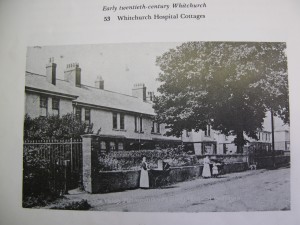From 1915 to 1919, Cardiff City Mental Hospital was taken over by the Army Council as a general medical and surgical war hospital and was renamed the Welsh Metropolitan War Hospital. The majority of the existing patients, some 572 men and women, were transferred to neighbouring mental hospitals at Bridgend, Carmarthen, Newport, Abergavenny, Talgarth, Hereford and Gloucester, apart from 45 men, described as ‘harmless patients of the demented class’, who were retained to work on the hospital farm.
The Welsh Metropolitan War Hospital was opened 9th June 1915, by Sir William James Thomas. The rationale for choosing Whitchurch was that is had the right infrastructure to support needs of a military hospital, including recreation halls and extensive grounds to keep the patients, who were generally young men, occupied and entertained. It was also near large towns to enable surgeons / physicians to be readily available and close to road / rail. As part of the Asylum War Hospital scheme of 1915, an extra 50,000 military beds were created in this way. Asylums were grouped geographically and one from each group was chosen as a war hospital, their patients being relocated within their group. Overcrowding estimated to be 5-10%, which was considered acceptable in a wartime national emergency. The scheme began with 9 asylum war hospitals, but quickly rose to 10. Money was spent to improve the hospitals veranda’s, labs, theatres and install electrical treatment equipment to the tune of £4,600.
Male staff who hadn’t been called up for military service became enlisted in Royal Army Med. Corps. Dr. Goodall, former Medical Superintendent, assumed the rank of Lt. Colonel and reported to the war office rather than the hospital management committee. His deputy Dr. Barton-White, became a Major and Matron Florence Raines, remained and was given responsibility for all the nursing staff, including the male nurses.
Traditionally male nursing staff had always looked after the male patients, but because many of the male staff had been called up for military service, female nurses had to look after male patients for the first time in the hospitals history. This arrangement was continued by Dr. Goodall after the war, partly because of its success and popularity among staff and patients and partly because it was seen as a way of moving away from the traditional roles associated with an asylum.
In the early part of the war, the hospital it became a specialist centre for the treatment of orthopaedic cases., but by 1917, 450 beds were put aside for soldiers with mental health problems. Dr. Goodall insisted the staff caring for these patients must be properly trained. By the end of the war, 9,997 sick/wounded men were treated and 1,883 mental/neurological cases.
Although the war ended in 1918, the hospital remained under military control until 31st December 1919. Lt. Colonel Goodall wrote a strong letter sent reminding war office of the agreement to return to the hospital to civilian use 6 months after the end of the war. After extensive refurbishment, on 20th October 1920 returned to its normal use with the benefit of a new dispensary, X ray department and cinema. 251 male and 306 female mental patients returned, however 48 were unaccounted for. The hospital staff returned to their civilian roles.
Thanks again to Tim Goosey for this post.

Welsh Metropolitan Military Hospital Cottages

The Welsh Metrpolitan Military Hospital
Dear Sir,
During WW1, my grandmother Barbara (Jeanette) Labyt, belgian ,
lived with her family in Cardiff.
I have pictures of her wearing red cross-outfit, father always claimed she worked as a nurse in Whitchurch.
Is there any possibility to find anything about her in archives?
After the war, way 1931, she married my grandfather, who served Albert 1 liberation army,
Thank you very much for any information,
Kind regards,
Carl Debruyne
Marktplein 13
8620 Nieuwpoort – Belgium
sandhove@hotmail.com